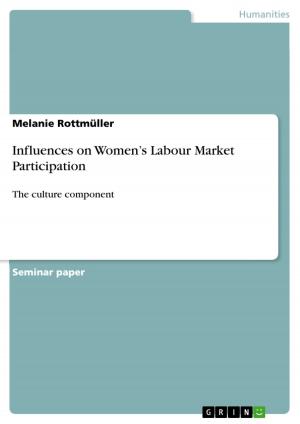The function of food representation and eating in John Irving's 'The Cider House Rules'
Nonfiction, Entertainment, Drama, Anthologies| Author: | Phyllis Wiechert | ISBN: | 9783638734035 |
| Publisher: | GRIN Publishing | Publication: | May 4, 2007 |
| Imprint: | GRIN Publishing | Language: | English |
| Author: | Phyllis Wiechert |
| ISBN: | 9783638734035 |
| Publisher: | GRIN Publishing |
| Publication: | May 4, 2007 |
| Imprint: | GRIN Publishing |
| Language: | English |
Seminar paper from the year 2000 in the subject American Studies - Literature, grade: 2+, Free University of Berlin (Institut für Englisch Philologie), course: Food and Drink in film and literature, 13 entries in the bibliography, language: English, abstract: The purpose of this paper is to analyze the question of the function of food representation and eating in the novel 'The Cider House Rules' by John Irving, first published in 1985 by William Morrow. The relevance of this question can already be found in the title of the novel. Since the title 'The Cider House Rules' combines food, or better drink with rules and housing, there must be some deeper connection between them. What exactly is meant by these rules? These rules must be social agreements, which again are connected to food and drink. The novel also relates to a local and regional culture, the culture of apple growing, to Maine, and to certain social structures. It would be of interest to analyze the influence food has on the novel's main characters. All these questions lead to the main question and are going to focus on the function that food and drink have in the novel. In the first part, this paper gives background information on the novel's settings in Maine and gives theoretical reference to the cultural anthropologist Claude Levi-Strauss and the social and literary critic Roland Barthes. The second part will then focusing on Homer Wells, one of the main characters in the novel. It concentrates on the influences the other characters have on Homer Wells, especially Dr. Larch, Melony, Candy, Wally, and the migrants. Then the symbolic meaning of apples will be discussed. Homer Wells' most forming moments on the orchard will be explained and also how his life is connected with apple farming. In the third part the relation of the title and the novel will be analyzed. This includes also the reasons for the cider house. The results will be summarized in the end.
Seminar paper from the year 2000 in the subject American Studies - Literature, grade: 2+, Free University of Berlin (Institut für Englisch Philologie), course: Food and Drink in film and literature, 13 entries in the bibliography, language: English, abstract: The purpose of this paper is to analyze the question of the function of food representation and eating in the novel 'The Cider House Rules' by John Irving, first published in 1985 by William Morrow. The relevance of this question can already be found in the title of the novel. Since the title 'The Cider House Rules' combines food, or better drink with rules and housing, there must be some deeper connection between them. What exactly is meant by these rules? These rules must be social agreements, which again are connected to food and drink. The novel also relates to a local and regional culture, the culture of apple growing, to Maine, and to certain social structures. It would be of interest to analyze the influence food has on the novel's main characters. All these questions lead to the main question and are going to focus on the function that food and drink have in the novel. In the first part, this paper gives background information on the novel's settings in Maine and gives theoretical reference to the cultural anthropologist Claude Levi-Strauss and the social and literary critic Roland Barthes. The second part will then focusing on Homer Wells, one of the main characters in the novel. It concentrates on the influences the other characters have on Homer Wells, especially Dr. Larch, Melony, Candy, Wally, and the migrants. Then the symbolic meaning of apples will be discussed. Homer Wells' most forming moments on the orchard will be explained and also how his life is connected with apple farming. In the third part the relation of the title and the novel will be analyzed. This includes also the reasons for the cider house. The results will be summarized in the end.















